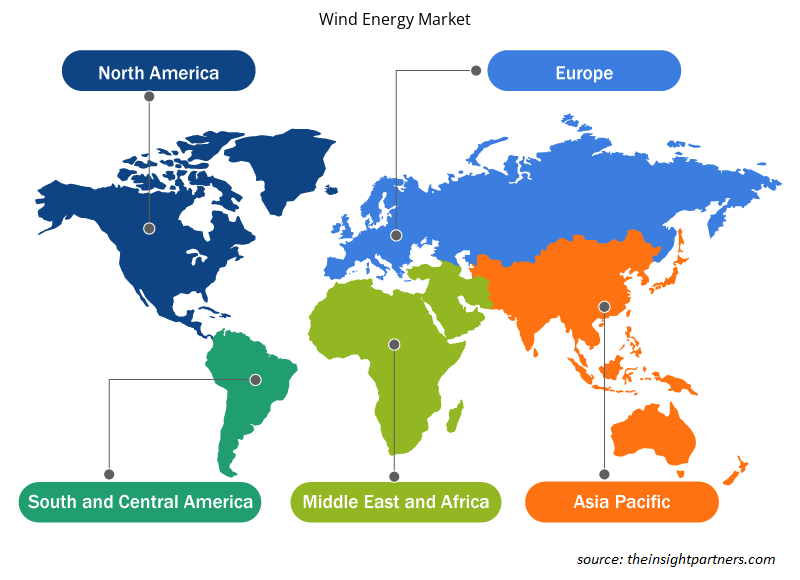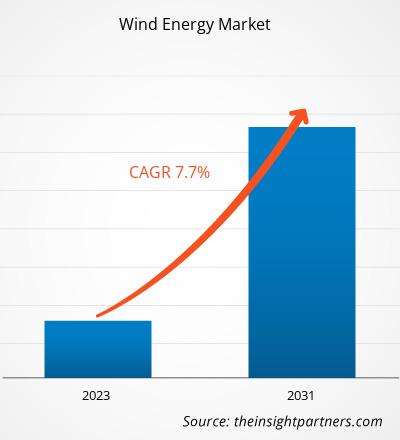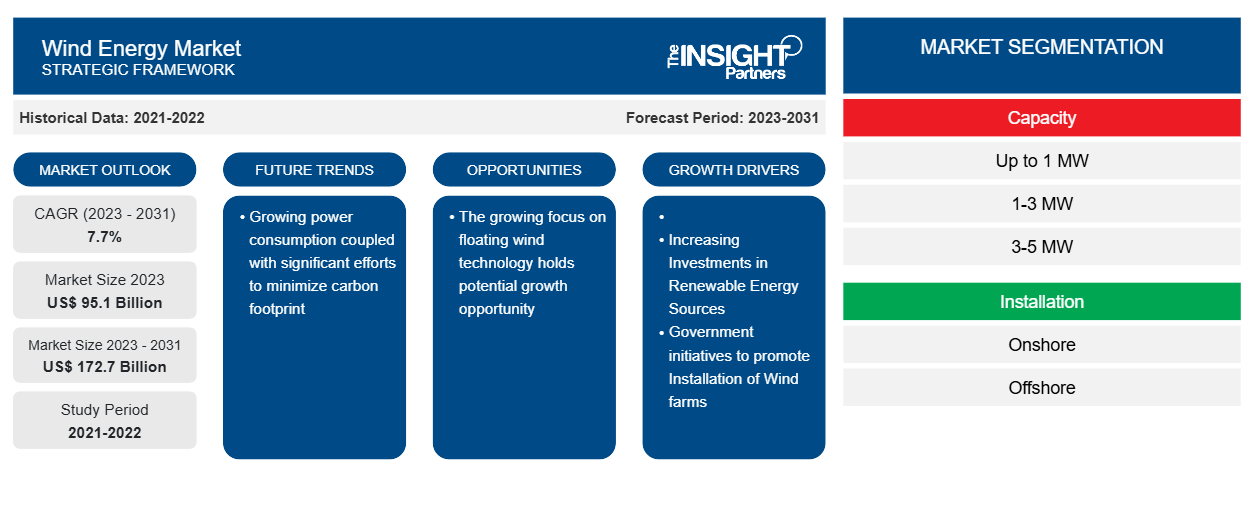Der Markt für Windenergie soll von 95,1 Milliarden US-Dollar im Jahr 2023 auf 172,7 Milliarden US-Dollar im Jahr 2031 anwachsen. Der Markt soll zwischen 2023 und 2031 eine durchschnittliche jährliche Wachstumsrate (CAGR) von 7,7 % verzeichnen. Der steigende Energieverbrauch in Verbindung mit erheblichen Anstrengungen zur Minimierung der CO2-Emissionen ist einer der Hauptfaktoren, die den Windenergiemarkt antreiben.
Windenergie-Marktanalyse
Der Windenergiemarkt dürfte im analysierten Zeitraum aufgrund der zunehmenden Zahl von Onshore- und Offshore-Windkraftprojekten, insbesondere an abgelegenen Standorten, ein erhebliches Wachstum verzeichnen. Darüber hinaus dürften die staatlichen Vorschriften zur Reduzierung der CO2-Emissionen durch die Konzentration auf die Stromerzeugung durch erneuerbare Energiequellen wie Wind, Sonne, Geothermie und andere das Marktwachstum von 2023 bis 2031 vorantreiben. Darüber hinaus dürften staatliche Initiativen zur Errichtung von Windparks auf der ganzen Welt das Marktwachstum in den kommenden Jahren ankurbeln.
Marktübersicht Windenergie
Mit der wachsenden Bevölkerung und Industrialisierung steigt auch der Energiebedarf auf globaler Ebene. Der Anstieg des Energieverbrauchs steigerte auch den Bedarf an erneuerbarer Energieerzeugung in Entwicklungs- und Industrieländern. Dies hat zu einer steigenden Nachfrage nach Windkraftinfrastruktur auf der ganzen Welt geführt. Die Windenergieerzeugung hat im Vergleich zu anderen erneuerbaren Energiequellen weltweit an Bedeutung und Akzeptanz gewonnen. Fortschrittliche technologische Entwicklungen bei Design und Entwicklung von Windkraftblättern, Turbinen , Wellen und anderen Komponenten haben zu deutlichen Fortschritten bei der Nutzung der Windenergie und der maximalen Energieausbeute aus dem verfügbaren Wind beigetragen. Laut der Internationalen Agentur für Erneuerbare Energien (IRENA) erreichte die weltweit installierte Windkapazität bis Ende 2023 1.017 GW (von 825 GW im Jahr 2021). Daher wird erwartet, dass sich diese installierte Windkapazität in den kommenden Jahren aufgrund der Vorteile der Windenergie sowie günstiger Richtlinien, Anreize und Steuererleichterungen weiter erhöhen wird.
Passen Sie diesen Bericht Ihren Anforderungen an
Sie erhalten kostenlos individuelle Anpassungen an jedem Bericht, einschließlich Teilen dieses Berichts oder einer Analyse auf Länderebene, eines Excel-Datenpakets sowie tolle Angebote und Rabatte für Start-ups und Universitäten.
-
Holen Sie sich die wichtigsten Markttrends aus diesem Bericht.Dieses KOSTENLOSE Beispiel umfasst eine Datenanalyse von Markttrends bis hin zu Schätzungen und Prognosen.
Treiber und Chancen auf dem Windenergiemarkt
Regierungsinitiativen zur Förderung der Errichtung von Windparks gelten als wichtigster Wachstumsmotor für den Windenergiemarkt.
Die zunehmende Unterstützung durch verschiedene Regierungen verschiedener Länder in Form von Richtlinien, Subventionen und Investitionen zur Steigerung der Installation von Windenergieprojekten wird voraussichtlich das Wachstum des Windenergiemarktes im analysierten Zeitraum ankurbeln. Die indische Regierung ist bestrebt, Windkraftanlagen im Land durch private Finanzierung zu fördern, indem sie verschiedene steuerliche und finanzielle Anreize wie beschleunigte Abschreibungsvorteile und ermäßigte Zölle oder Steuerbefreiungen für bestimmte Komponenten von Windkraftgeneratoren bietet. So plant Deutschland beispielsweise die Einführung eines Gesetzes zur Beschleunigung des Ausbaus der Windenergie. Das neue Gesetz wird verbindliche Flächenziele für den Ausbau der Onshore-Windenergie in den Bundesländern festlegen. Im April 2022 plante Deutschland, mithilfe eines historischen Pakets namens Osterpaket, das die tiefgreifendste Reihe von Änderungen in der deutschen Energiepolitik darstellt, ab 2025 Offshore-Windziele auf über 10 GW pro Jahr auszudehnen. Mithilfe dieser Regierungsinitiativen werden bis 2030 80 % des deutschen Strombedarfs durch Strom aus erneuerbaren Energiequellen gedeckt.
Der zunehmende Fokus auf schwimmende Windtechnologie birgt potenzielle Wachstumschancen.
Bei der schwimmenden Windtechnologie handelt es sich um eine Offshore-Windturbine, die auf einer schwimmenden Struktur im Meer montiert ist, die sicherstellt, dass die Turbine in Wassertiefen Strom erzeugt. Die schwimmende oder Offshore-Windtechnologie ist unter rauen Umweltbedingungen hocheffizient und kann daher enorme Mengen Strom erzeugen. Diese schwimmende Windtechnologie wird weltweit in verschiedenen Ländern wie China, Deutschland, Japan, Großbritannien, Frankreich, Belgien und Dänemark eingesetzt. Die Wachstumsaussichten bei der Einführung der schwimmenden Windtechnologie sind in erster Linie auf einen zunehmenden technologischen Fortschritt, die damit verbundenen Vorteile und die schlüsselfertigen Lösungen verschiedener Dienstleister zurückzuführen. Das wachsende Bewusstsein für die Erreichung der Ziele für saubere Energie in verschiedenen Ländern treibt die Nachfrage nach schwimmender Offshore-Windkraft an, was potenzielle Chancen für das Wachstum des Windenergiemarktes bietet.
Der Bericht des Floating Offshore Wind Centre of Excellence hat 22 Länder identifiziert, die am ehesten bereit sind, wichtige Akteure in der aufkommenden Technologie für erneuerbare Energien zu werden. Im Januar 2022 kündigte die britische Regierung 11 Projekte für erneuerbare Energien an, die jeweils mit bis zu 959,23 Millionen US-Dollar gefördert werden. Damit stellt sie 2,97 Milliarden US-Dollar bereit, um die in Großbritannien erzeugte erneuerbare Energie zu steigern. Solche Investitionen in Offshore- oder schwimmende Windtechnologie auf der ganzen Welt werden voraussichtlich das Marktwachstum in den kommenden Jahren ankurbeln.
Segmentierungsanalyse des Windenergiemarktberichts
Schlüsselsegmente, die zur Ableitung der Windenergiemarktanalyse beigetragen haben, sind Kapazität und Installation.
- Basierend auf der Kapazität wurde der Windenergiemarkt in bis zu 1 MW, 1-3 MW, 3-5 MW und über 5 MW unterteilt. Das 1-3 MW-Segment hatte im Jahr 2023 einen größeren Marktanteil.
- Basierend auf der Installation wurde der Windenergiemarkt in Onshore und Offshore unterteilt. Das Onshore-Segment hatte im Jahr 2023 einen größeren Marktanteil.
Windenergie-Marktanteilsanalyse nach geografischer Lage
Der geografische Umfang des Windenergiemarktberichts ist hauptsächlich in fünf Regionen unterteilt: Nordamerika, Europa, Asien-Pazifik, Naher Osten und Afrika sowie Südamerika.
Der asiatisch-pazifische Raum wird 2023 den Windenergiemarkt dominieren. Der asiatisch-pazifische Raum umfasst Australien, China, Japan, Indien, Südkorea und den Rest des asiatisch-pazifischen Raums. Das Wachstum der Windenergiebranche im asiatisch-pazifischen Raum ist in erster Linie auf steigende Investitionen in erneuerbare Energien, exponentielle Zunahme der Industrialisierung und Urbanisierung, Windenergieerzeugungskapazität, neue Elektrifizierungsprojekte und Initiativen zur Stärkung des Stromnetzes zurückzuführen. Laut IRENA und den Zielen Chinas für erneuerbare Energien könnte das Land von 2021 bis 2030 neue Offshore-Windkraftkapazitäten im Wert von über 90 GW hinzufügen. Der Windenergiesektor im asiatisch-pazifischen Raum wird voraussichtlich schnell wachsen. Laut einer neuen Studie könnte er in diesem Jahrzehnt fast ein Viertel des Stromkapazitätsmix in der Region ausmachen, da die hohe Inlandsnachfrage nach Offshore-Windkraft das chinesische Festland bis 2030 zum größten Markt der Welt macht.
Regionale Einblicke in den Windenergiemarkt
Die regionalen Trends und Faktoren, die den Windenergiemarkt im Prognosezeitraum beeinflussen, wurden von den Analysten von Insight Partners ausführlich erläutert. In diesem Abschnitt werden auch die Marktsegmente und die Geografie des Windenergiemarkts in Nordamerika, Europa, im asiatisch-pazifischen Raum, im Nahen Osten und Afrika sowie in Süd- und Mittelamerika erörtert.

- Erhalten Sie regionale Daten zum Windenergiemarkt
Umfang des Windenergiemarktberichts
| Berichtsattribut | Details |
|---|---|
| Marktgröße im Jahr 2023 | 95,1 Milliarden US-Dollar |
| Marktgröße bis 2031 | 172,7 Milliarden US-Dollar |
| Globale CAGR (2023 - 2031) | 7,7 % |
| Historische Daten | 2021-2022 |
| Prognosezeitraum | 2023–2031 |
| Abgedeckte Segmente |
Nach Kapazität
|
| Abgedeckte Regionen und Länder |
Nordamerika
|
| Marktführer und wichtige Unternehmensprofile |
|
Akteuredichte auf dem Windenergiemarkt: Auswirkungen auf die Geschäftsdynamik verstehen
Der Markt für Windenergie wächst rasant. Die steigende Nachfrage der Endverbraucher ist auf Faktoren wie sich entwickelnde Verbraucherpräferenzen, technologische Fortschritte und ein größeres Bewusstsein für die Vorteile des Produkts zurückzuführen. Mit der steigenden Nachfrage erweitern Unternehmen ihr Angebot, entwickeln Innovationen, um die Bedürfnisse der Verbraucher zu erfüllen, und nutzen neue Trends, was das Marktwachstum weiter ankurbelt.
Die Marktteilnehmerdichte bezieht sich auf die Verteilung der Firmen oder Unternehmen, die in einem bestimmten Markt oder einer bestimmten Branche tätig sind. Sie gibt an, wie viele Wettbewerber (Marktteilnehmer) in einem bestimmten Marktraum im Verhältnis zu seiner Größe oder seinem gesamten Marktwert präsent sind.
Die wichtigsten auf dem Windenergiemarkt tätigen Unternehmen sind:
- Vestas Wind Systems A/S
- Siemens Energy
- Goldwind
- ENVISION-Gruppe
- GE Erneuerbare Energien
- Mingyang Intelligente Energie
Haftungsausschluss : Die oben aufgeführten Unternehmen sind nicht in einer bestimmten Reihenfolge aufgeführt.

- Überblick über die wichtigsten Akteure auf dem Windenergiemarkt
Neuigkeiten und aktuelle Entwicklungen auf dem Windenergiemarkt
Der Windenergiemarkt wird durch die Erhebung qualitativer und quantitativer Daten nach Primär- und Sekundärforschung bewertet, die wichtige Unternehmensveröffentlichungen, Verbandsdaten und Datenbanken umfasst. Im Folgenden finden Sie eine Liste der Entwicklungen auf dem Windenergiemarkt und der Strategien:
- Im Juni 2022 ging Vestas eine Partnerschaft mit PEC Energia für einen 86-MW-Windpark in Brasilien ein. Mit diesem Projekt übertraf Vestas den Meilenstein von 7 GW Auftragseingang in Brasilien seit 2018.
- Im September 2021 hat der Windturbinenhersteller Goldwind seine 5-Megawatt-Testeinheit an Land an das Stromnetz angeschlossen und bereitet sich auf den Beginn der Auslieferungen im Jahr 2022 vor. Die 5S Smart Wind Turbine von Goldwind mit Permanentmagnet-Direktantrieb (PMDD) an Land verfügt über einen Rotordurchmesser von 165 m und Nabenhöhen von 100 bis 130 Metern.
Bericht zum Windenergiemarkt: Abdeckung und Ergebnisse
Der Bericht „Marktgröße und Prognose für Windenergie (2021–2031)“ bietet eine detaillierte Analyse des Windenergiemarktes in den folgenden Bereichen:
- Marktgröße und Prognose auf globaler, regionaler und Länderebene für alle wichtigen Marktsegmente, die im Rahmen des Projekts abgedeckt sind
- Marktdynamik wie Treiber, Beschränkungen und wichtige Chancen
- Wichtige Zukunftstrends
- Detaillierte Porter's Five Forces Analyse
- Globale und regionale Marktanalyse mit wichtigen Markttrends, wichtigen Akteuren, Vorschriften und aktuellen Marktentwicklungen
- Branchenlandschaft und Wettbewerbsanalyse, einschließlich Marktkonzentration, Heatmap-Analyse, prominenten Akteuren und aktuellen Entwicklungen
- Detaillierte Firmenprofile mit SWOT-Analyse
- Historische Analyse (2 Jahre), Basisjahr, Prognose (7 Jahre) mit CAGR
- PEST- und SWOT-Analyse
- Marktgröße Wert/Volumen – Global, Regional, Land
- Branchen- und Wettbewerbslandschaft
- Excel-Datensatz
Aktuelle Berichte
Verwandte Berichte
Erfahrungsberichte
Grund zum Kauf
- Fundierte Entscheidungsfindung
- Marktdynamik verstehen
- Wettbewerbsanalyse
- Kundeneinblicke
- Marktprognosen
- Risikominimierung
- Strategische Planung
- Investitionsbegründung
- Identifizierung neuer Märkte
- Verbesserung von Marketingstrategien
- Steigerung der Betriebseffizienz
- Anpassung an regulatorische Trends























 Kostenlose Probe anfordern für - Windenergiemarkt
Kostenlose Probe anfordern für - Windenergiemarkt